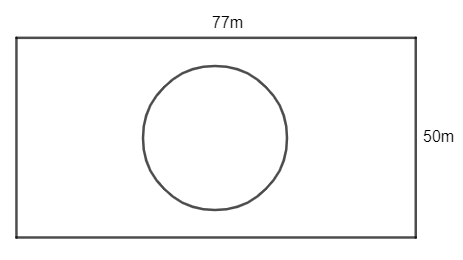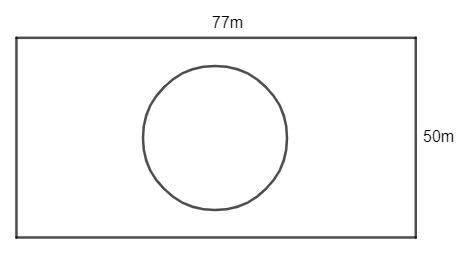
The length and breadth of a rectangular garden are 77m and 50m. There is a circular lake in the garden having a diameter of 14m. Due to wind, a towel from a terrace on a nearby building fell into the garden. Then find the probability of the event that it fell in the lake.


Answer
564k+ views
Hint: To solve this question, we will, first of all, calculate the area of the rectangular park and the area of the circular lake using the formula stated as \[\text{Area of rectangle}=\text{Length}\times \text{Breadth}\] and \[\text{Area of circular lake}=\pi {{r}^{2}}\] where r is the radius of the circle. The probability can be determined using the formula, \[\text{Probability}=\dfrac{\text{Favorable Outcomes}}{\text{Total number of outcomes}}.\] Here, the total outcome is the same as the area of the rectangular garden as the total outcome = total area on which the towel can fall. And the favourable outcomes will be equal to the area of the circular lake as we want to calculate the probability of falling off the towel into the lake.
Complete step-by-step answer:
We are given the rectangular garden as

The diameter ‘d’ of the circular lake is d = 14m. Let us first calculate the area of the garden. Because the garden is rectangular, the area of the garden is equal to the area of the rectangle. The area of the rectangle is given by \[\text{Length}\times \text{Breadth}\text{.}\]
We are given the length, l as 77m and breadth b as 50m. Then the area of the rectangular garden by using the above formula is
\[\Rightarrow \text{Area of rectangle}=77\times 50\]
\[\Rightarrow \text{Area of rectangle}=3850\]
The area ‘A” of the rectangular garden is \[3850{{m}^{2}}.\] The given diameter ‘d’ of the lake is, d = 14m, then the radius of the lake ‘r’ can be calculated by dividing the diameter ‘d’ by 2.
\[\Rightarrow \text{radius }r=\dfrac{d}{2}=\dfrac{14}{2}=7m\]
Finally, we will calculate the area of the circular lake. The formula of the area of the circle is given by \[{{A}^{'}}=\pi {{r}^{2}}\] where ‘r’ is the radius of the circle.
Here, r = radius = 7m.
\[\Rightarrow \text{Area of circular lake, }{{\text{A}}^{'}}=\pi {{\left( 7 \right)}^{2}}\]
\[\Rightarrow \text{Area of circular lake, }{{\text{A}}^{'}}=48\pi \]
Using \[\pi =\dfrac{22}{7},\] we have,
\[\Rightarrow \text{Area of circular lake, }{{\text{A}}^{'}}=48\times \dfrac{22}{7}\]
\[\Rightarrow \text{Area of circular lake, }{{\text{A}}^{'}}=154\]
Then the probability of the event that it will fall in the lake is obtained by using the formula, \[\text{Probability}=\dfrac{\text{Favorable Outcomes}}{\text{Total number of outcomes}}.\]
A favorable outcome is given by the area of the circular lake, i.e. \[154{{m}^{2}}.\]
And the total number of outcome = area of the rectangular garden which is \[3850{{m}^{2}}.\]
\[\Rightarrow \text{Probability}=\dfrac{154}{3850}=\dfrac{1}{25}\]
Therefore, the probability that it will fall into the lake is \[\dfrac{1}{25}.\]
Note: Most students do not understand the question when they read it and often leave it unattempted. They just have to recollect the basic concepts and then relate the given data in the question to it. So, here they must first recollect the formula of probability. Then, reading the question, they will realise that the total number of outcomes would be the area of the rectangular garden. Similarly, they will be able to comprehend the favourable outcomes too. Do not make the mistake of subtracting the area of the lake from the rectangular garden and taking it as the total number of outcomes.
Complete step-by-step answer:
We are given the rectangular garden as

The diameter ‘d’ of the circular lake is d = 14m. Let us first calculate the area of the garden. Because the garden is rectangular, the area of the garden is equal to the area of the rectangle. The area of the rectangle is given by \[\text{Length}\times \text{Breadth}\text{.}\]
We are given the length, l as 77m and breadth b as 50m. Then the area of the rectangular garden by using the above formula is
\[\Rightarrow \text{Area of rectangle}=77\times 50\]
\[\Rightarrow \text{Area of rectangle}=3850\]
The area ‘A” of the rectangular garden is \[3850{{m}^{2}}.\] The given diameter ‘d’ of the lake is, d = 14m, then the radius of the lake ‘r’ can be calculated by dividing the diameter ‘d’ by 2.
\[\Rightarrow \text{radius }r=\dfrac{d}{2}=\dfrac{14}{2}=7m\]
Finally, we will calculate the area of the circular lake. The formula of the area of the circle is given by \[{{A}^{'}}=\pi {{r}^{2}}\] where ‘r’ is the radius of the circle.
Here, r = radius = 7m.
\[\Rightarrow \text{Area of circular lake, }{{\text{A}}^{'}}=\pi {{\left( 7 \right)}^{2}}\]
\[\Rightarrow \text{Area of circular lake, }{{\text{A}}^{'}}=48\pi \]
Using \[\pi =\dfrac{22}{7},\] we have,
\[\Rightarrow \text{Area of circular lake, }{{\text{A}}^{'}}=48\times \dfrac{22}{7}\]
\[\Rightarrow \text{Area of circular lake, }{{\text{A}}^{'}}=154\]
Then the probability of the event that it will fall in the lake is obtained by using the formula, \[\text{Probability}=\dfrac{\text{Favorable Outcomes}}{\text{Total number of outcomes}}.\]
A favorable outcome is given by the area of the circular lake, i.e. \[154{{m}^{2}}.\]
And the total number of outcome = area of the rectangular garden which is \[3850{{m}^{2}}.\]
\[\Rightarrow \text{Probability}=\dfrac{154}{3850}=\dfrac{1}{25}\]
Therefore, the probability that it will fall into the lake is \[\dfrac{1}{25}.\]
Note: Most students do not understand the question when they read it and often leave it unattempted. They just have to recollect the basic concepts and then relate the given data in the question to it. So, here they must first recollect the formula of probability. Then, reading the question, they will realise that the total number of outcomes would be the area of the rectangular garden. Similarly, they will be able to comprehend the favourable outcomes too. Do not make the mistake of subtracting the area of the lake from the rectangular garden and taking it as the total number of outcomes.
Recently Updated Pages
Master Class 12 Business Studies: Engaging Questions & Answers for Success

Master Class 12 Social Science: Engaging Questions & Answers for Success

Master Class 12 English: Engaging Questions & Answers for Success

Master Class 12 Chemistry: Engaging Questions & Answers for Success

Class 12 Question and Answer - Your Ultimate Solutions Guide

Master Class 12 Economics: Engaging Questions & Answers for Success

Trending doubts
How much time does it take to bleed after eating p class 12 biology CBSE

When was the first election held in India a 194748 class 12 sst CBSE

December 10th of 1948 is an important day in the history class 12 sst CBSE

The computer jargonwwww stands for Aworld wide web class 12 physics CBSE

The first microscope was invented by A Leeuwenhoek class 12 biology CBSE

Give simple chemical tests to distinguish between the class 12 chemistry CBSE




